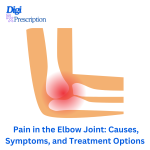
Your elbow might not get much attention—until it starts to hurt. Elbow joint pain can interfere with everything from lifting groceries to typing an email. Understanding what's behind that ache or twinge is the first step toward finding relief.
In this post, we’ll explore the common causes of elbow joint pain, symptoms to watch for, and how to treat and prevent it.
What Causes Elbow Joint Pain?
Pain in the elbow can stem from a variety of sources, ranging from overuse to injury. Here are the most common culprits:
1. Tennis Elbow (Lateral Epicondylitis)
-
Common in athletes, desk workers, or anyone doing frequent gripping.
-
Pain occurs on the outside of the elbow.
2. Golfer’s Elbow (Medial Epicondylitis)
-
Caused by overuse of the forearm muscles.
3. Bursitis
-
Inflammation of the bursa (a small fluid-filled sac) in the elbow.
-
Can be caused by leaning on elbows too much or by trauma/infection.
4. Arthritis
-
Osteoarthritis or rheumatoid arthritis can both affect the elbow.
-
Pain is usually accompanied by stiffness and reduced range of motion.
5. Elbow Fractures or Dislocations
-
Result from direct trauma or falls.
-
Often accompanied by swelling, bruising, and inability to move the joint.
6. Nerve Compression (e.g., Cubital Tunnel Syndrome)
-
Compression of the ulnar nerve (a.k.a. the “funny bone” nerve).
-
May cause numbness or tingling in the ring and pinky fingers.
Symptoms to Watch For
-
Sharp or dull pain in or around the elbow
-
Swelling or tenderness
-
Numbness or tingling in the fingers
-
Difficulty bending or straightening the arm
-
Weak grip strength
Treatment Options
Depending on the cause, treatment may involve:
✅ Conservative Methods
-
Rest & Ice: Reduce inflammation and pain.
-
Compression Bandages: Support the joint and limit movement.
-
Physical Therapy: Strengthen muscles and improve flexibility.
-
Anti-Inflammatory Medications: Ibuprofen or naproxen to reduce swelling.
Medical Procedures
-
Cortisone Injections: For severe inflammation.
-
Surgery: In rare cases, when conservative treatment fails.
Prevention Tips
-
Warm up before physical activity.
-
Avoid repetitive strain on the elbow joint.
-
Use ergonomic tools if you work long hours at a desk.
-
Strengthen forearm muscles with regular exercise.
-
Take breaks during repetitive tasks.
Final Thoughts
Elbow joint pain can be frustrating and disruptive, but with proper care, most cases are manageable. Don’t ignore early symptoms—early diagnosis and treatment are key to a full recovery. If your pain persists or worsens, consult a healthcare professional to rule out more serious conditions.
Suggested References (Credible Sources)
-
Mayo Clinic – Elbow Pain
https://www.mayoclinic.org/symptoms/elbow-pain/basics/definition/sym-20050874 -
Cleveland Clinic – Elbow Conditions
https://my.clevelandclinic.org/health/diseases/21764-elbow -
Johns Hopkins Medicine – Elbow Injuries and Disorders
https://www.hopkinsmedicine.org/health/conditions-and-diseases/elbow-problems
